The Great Wildebeest Migration, also called the Gnu Migration, Serengeti Migration, and Masai Mara Migration, is a significant movement of land animals that remains on the planet.
Tourists often go to Kenya and Tanzania for a Migration safari, primarily during mid-year.
Although timing is critical for the Migration, the animals’ movements cannot be predicted.
The wildebeest, along with a few zebras and antelopes, are expected to cross the Mara River, and rainfall is expected to prompt them to migrate to new grazing areas, but the exact timing is uncertain.
Luckily, the planning of Wildebeest Migration safaris has been ongoing since 1998, assisting thousands of travelers in being in the right place at the right time for the best price.
In this guide, we have compiled our detailed expert planning advice.
It is impossible to predict when the wildebeest/ Gnu will cross the river during the Migration?
Some cross right away while others spend days grazing or turn back.
Nobody can accurately predict the crossings, so it’s best to allow plenty of time on safari to increase the chances of witnessing one.
When does the Wildbeest/ Gnu migration happen?
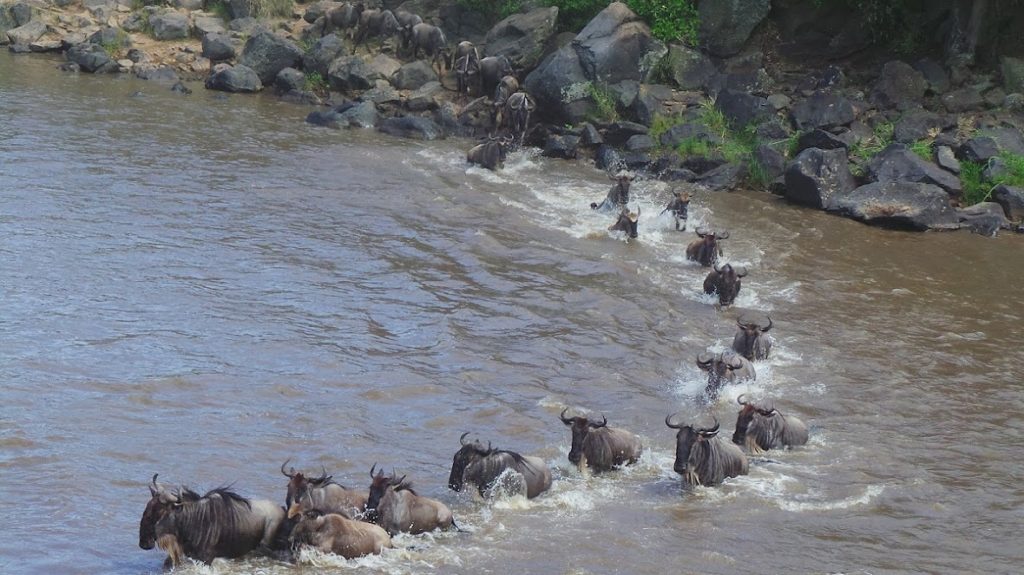
The Wildebeest Migration is not limited to a specific month, as it is an ongoing circular migration with different exciting events happening throughout the year.
While the popular river crossings are often observed during the high safari season (June to October), the wildebeest are moving and visible throughout the year.
Where Does the Great Migration Start?
The Great Migration is a continuous movement of around two million animals across the Serengeti-Mara ecosystem with no fixed starting or ending points.
The migration is initiated by rains in East Africa, after which the wildebeest follow a traditional route in search of fresh water and pasture, crossing the Masai Mara plains in Kenya and moving southwards into Tanzania’s Serengeti and the periphery of the Ngorongoro Crater, before returning in a clockwise direction.
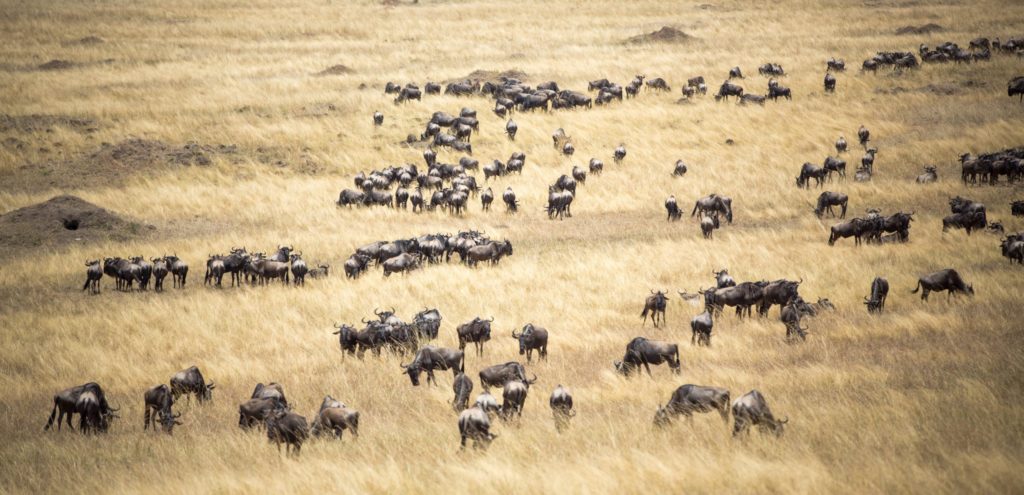
Why Do Wildebeest/ Gnu Migrate?
The Great Migration in Africa is mainly driven by the wildebeest’s response to weather and the availability of food. They move in search of new grass after the rains, following their natural instinct to survive.
While some experts believe that distant lightning and thunderstorms can trigger the wildebeest to move, there is no scientific evidence to support this theory.
What usually happens on?
Due to climate change, the long and short rainy seasons in Kenya and Tanzania are no longer as dependable as they used to be. The rain can arrive early or late, and this can throw off the entire wildebeest migration schedule.
That’s why it’s important to plan for a more extended safari to increase your chances of witnessing the events. You can’t expect to fly in for just a few days, see a river crossing, and leave.
This is a general outline of the herds’ whereabouts throughout the year, but keep in mind that rain triggers the entire Gnu Migration and its timing may vary.
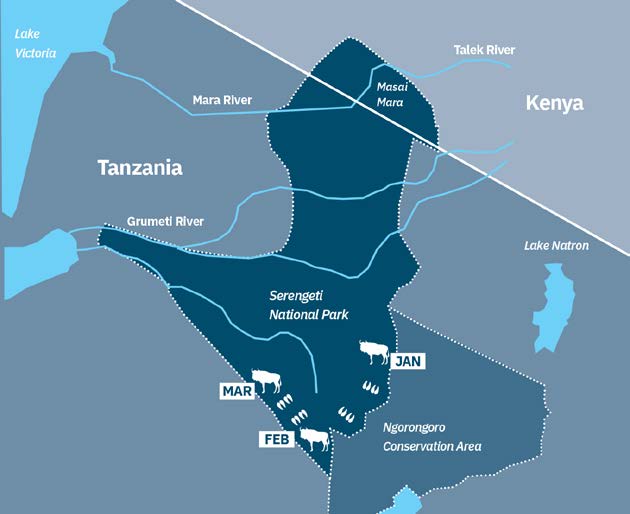
January
During January, the mega-herds of the Serengeti Migration, which consist of millions of wildebeest, zebras, and antelopes, are found in Tanzania’s Serengeti National Park.
They move in a southerly direction from the northeastern area to the Lake Ndutu region.
It’s important to note that the Serengeti is unfenced, allowing the animals to graze wherever they please.
The herds do not travel as a single group, but instead, break up into smaller groups consisting of thousands or hundreds of individuals.
February to March
During February to March, the Great Wildebeest Migration enters its calving season, with over 8,000 wildebeest babies being born each day.
This is a time when predators are actively hunting the calves, resulting in a bittersweet circle of life playing out as a live-action drama.
The Serengeti’s big cats are the primary predators, but other animals such as jackals, wild dogs, and hyenas also join in.
If the short rainy season has provided good grazing, the herds will feed extensively and stay in the southern plains of the Serengeti until March when they begin moving to the west.
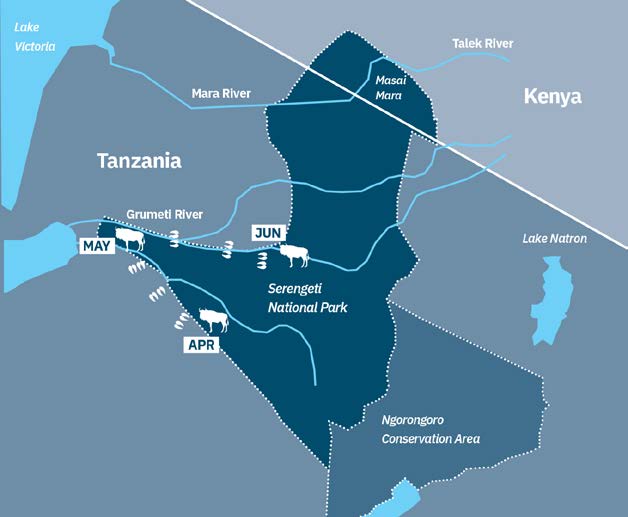
April
During April, which marks the beginning of the long rainy season, the herds of wildebeest typically move northwest toward the Moru and Simba Kopjes.
This is also the season of intense mating competition, during which male wildebeest engage in aggressive clashes for the opportunity to mate with females.
May
The herds continue to move, forming large columns that can stretch up to 40 kilometers as they make their way towards the central Serengeti. The calves are now stronger, allowing everyone to move a little faster.
June
The wildebeest are typically located in the central Serengeti and are preparing for the most challenging part of their journey.
Some of the herds may have divided, with a few already crossing the Grumeti River.
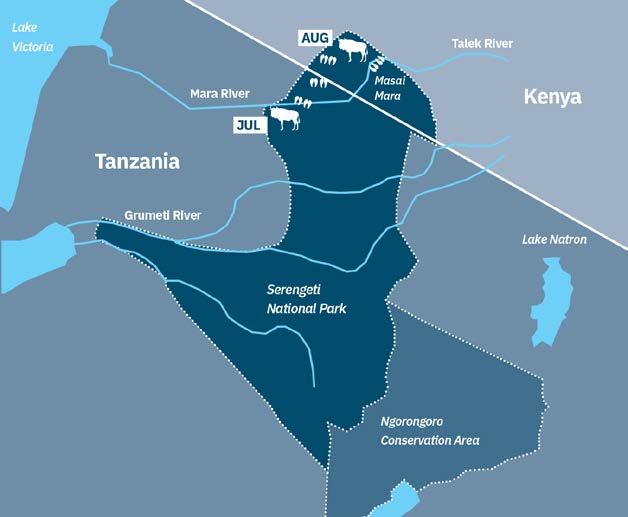
July
In July, the Great Migration usually arrives at the Grumeti region and the northern part of the Serengeti, and they begin to approach the perilous Mara River which they must cross to get to Kenya.
The river is home to enormous Nile crocodiles, which pose a significant threat.
However, it’s impossible to predict river crossings accurately since they depend on the weather and the unpredictable behavior of the wildebeest themselves.
To maximize the chances of seeing a crossing, it’s crucial to book a lodge on or near the river up to a year in advance, or choose a mobile safari camp that follows the Migration.
August
In August, the most recommended period to observe the breathtaking river crossings from the northern Serengeti to the Masai Mara, a passport is required to enter Kenya, unlike the wildebeest who don’t need any.
The Masai Mara National Reserve is accessible to everyone, but to have a more secluded safari, it’s advisable to visit the adjacent private conservancies.
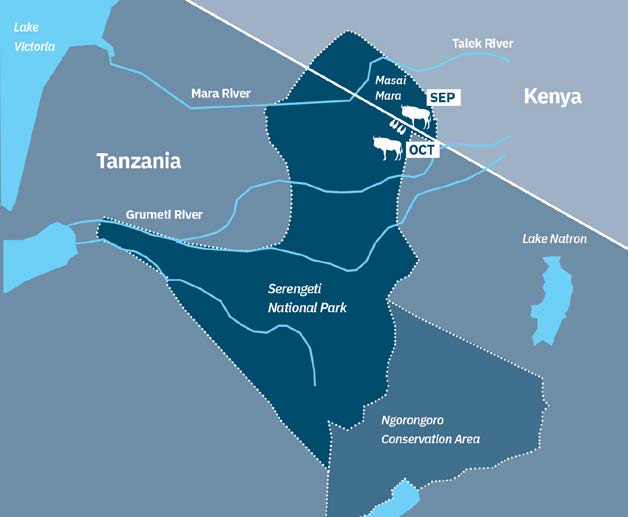
September
In September, the wildebeest herds start to separate into smaller groups, with less than half of the population remaining in the northern Serengeti, while the rest move to the Masai Mara.
Although it’s still possible to see wildebeest in the Serengeti, the best place to experience the Migration in September is generally considered to be the Masai Mara.
October
In October, the Masai Mara is still the recommended place to observe the Migration, although it is smaller and may be crowded with other visitors.
Private conservancies nearby offer a less crowded experience, as well as additional activities such as off-road game viewing, night drives, and walking safaris, which are not allowed in the national reserve.
Additionally, visiting these conservancies helps support the local Maasai communities.
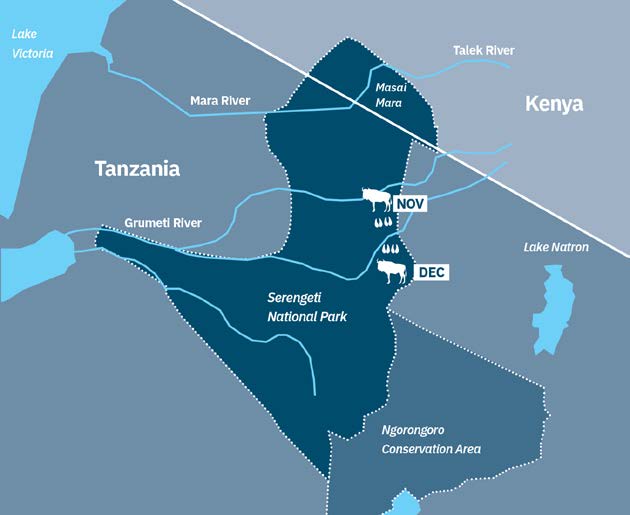
November
During a typical year, the short rainy season starts, which drives the wildebeest to leave the now barren grasslands of the Masai Mara and return to the revitalized Serengeti. Keep in mind that the rain can arrive early or late, which is also unpredictable.
The herds are on the move, but can be found in the northeastern parts of the Serengeti where they might divide into smaller groups for their journey southward.
Remember to bring appropriate clothing as the rain can cool things down significantly during early morning and late afternoon game drives.
December
The wildebeest are on the move again, heading south to graze and prepare for another risky 3,000-kilometer journey covering the northern and eastern Serengeti.
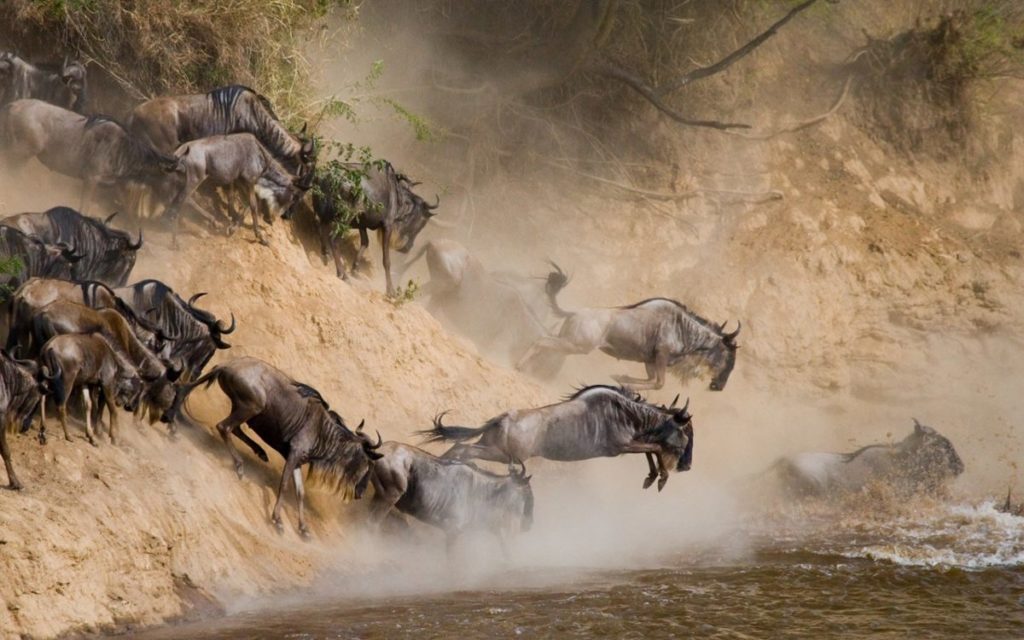
What is the optimal timing for a migration safari?
Knowing how the Great Wildebeest Migration in Africa works, you can see that the best time to go on a safari depends on what you want to see.
Keep in mind that the Serengeti and Masai Mara are great safari destinations throughout the year due to the abundance of wildlife and the vast landscapes.
Here are some important points to keep in mind:
- The majority of the Migration happens in the Serengeti.
- It is a circular journey that occurs throughout the year.
- River crossings cannot be accurately predicted, but typically happen between May and August.
- The animals are spread out over a large area and there are always some that are ahead and behind.
- Spending the whole day at a location where wildebeest have gathered may increase your chances of seeing a river crossing.
- If you are a photography enthusiast, the best time to take pictures might be around midday when the sun and glare are strongest, so plan accordingly.
An overview of the Great Wildebeest Migration by Months
| Month | Where can the wildebeest be found? | What are the current weather conditions? |
|---|---|---|
| January | Tanzania’s southern Serengeti (Lake Ndutu and Ngorongoro Conservation Area) | “Green season” (between the short rains and the long rains) |
| February | Tanzania’s southern Serengeti (Lake Ndutu) | Sporadic showers (the long rains are beginning) |
| March | Tanzania’s southern Serengeti (Lake Ndutu) | Long afternoon showers (the long rains are building up) |
| April | Tanzania’s Simba Kopjes and Moru | Consistent to heavy showers (height of the long rains) |
| May | Western corridor of Tanzania’s Serengeti | Rainfall is gradually tapering off, dry season begins |
| June | Northwest corner of Tanzania’s Serengeti | Sunny (dry season is in full swing) |
| July | Crossing of the Mara River in Tanzania’s Serengeti | Sunny (dry season is in full swing) |
| August | Crossing the border into Kenya’s Masai Mara | Sunny and dry days, high season starts to taper off |
| September | Kenya’s Masai Mara | Sunny and dry days, high season starts to taper off |
| October | Straddled between Kenya’s Masai Mara and Tanzania’s Serengeti | End of the dry season, high season crowds have thinned |
| November | Northeast corner of Tanzania’s Serengeti | Sporadic rains, the short rains begin |
| December | Southeast part of Tanzania’s Serengeti, toward Ndutu | Occasional rains, wet, height of the green season |
An overview of the Great Wildebeest Migration by Events
| Event | Approximate Time | Place |
|---|---|---|
| Calving (Birthing) Season | February to March | Southern Serengeti |
| Rutting (Breeding) Season | April to May | Western & Central Serengeti |
| Grumeti River Crossings | May to June | Central Serengeti |
| Mara River Crossings | July to August | Northern Serengeti & Masai Mara |
| Gnu on the Move | November to January | Masai Mara & Northern Serengeti to Southern Serengeti |




